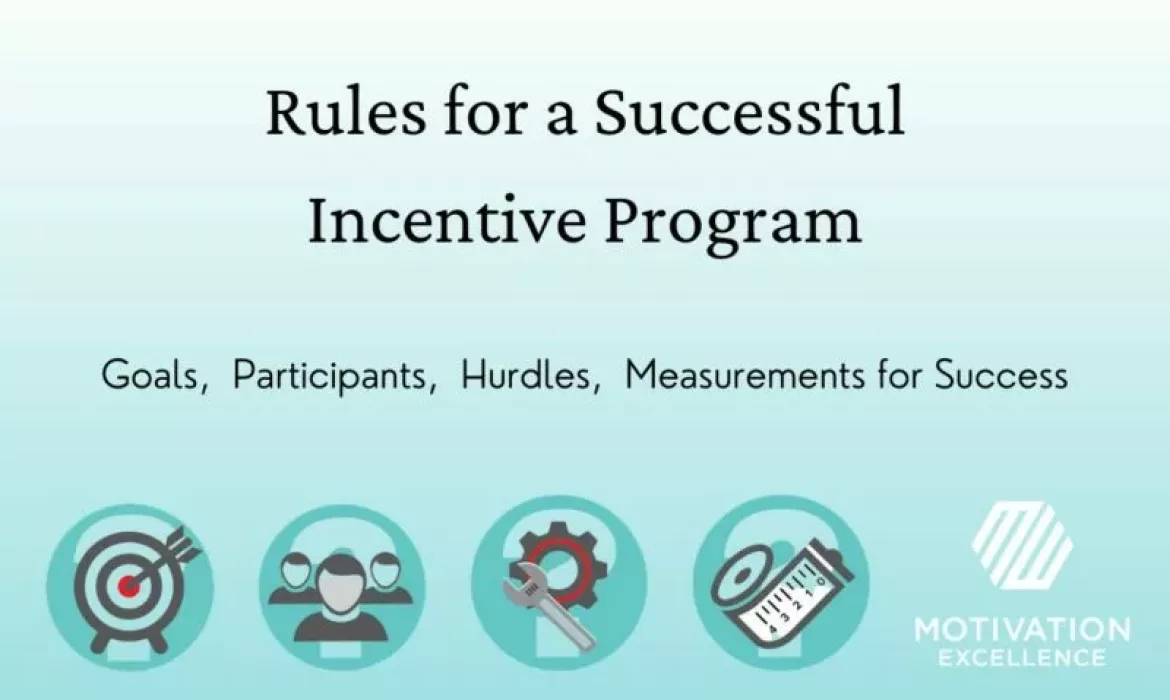
As you embark on launching a loyalty or incentive program, we know one of the most important factors to its success is the rules structure. Some of our clients want to write the rules themselves, while others look to us for expertise. In either scenario, we work together to create meaningful parameters that sets up success for you and your participants.
We recently recorded a less than 15-minute webinar looking at what goes into writing program rules and why they matter. Be sure to check it out in our newsroom at MotivationExcellence.com. Bob Graham, VP, Client & Technology Solutions and Rhonda Brewer, VP, Sales join me to discuss the vital ingredients to creating meaningful program guidelines.
The process always starts with in-depth conversations with you. There isn’t a set roadmap to follow, but rather a journey of discovery that could take some time. We look at the market, your competition, performance goals, past issues and future possibilities to name just a few avenues we explore.
There are key things to look at in a few broad categories that are universal. Below we list those and give you a real-life situation to illustrate them better.
Goals:
We need to pinpoint what you want or need to get out of the program. Is it increased mindshare, more revenue or stronger channel relationships? Are you hoping to reward loyalty, improve employee tenure or recognize achievements? It could be any of these, multiple options or something entirely different. Without clear goals, the water gets murky from the onset.
Client X is in the building supply industry and wants to launch a new product line within their distribution channel. There are already two competitors with similar products in the channel. The primary goal is to capture market share so that at least 2/3 of the channel buys Client X’s new product within one year. The secondary goal is to reward distributors for making the purchasing switch. These two goals give us plenty to work on within our rules structure. We know we need to identify the decision makers in the channel and find the best motivator to woo them to choose our client’s new products over the competitors’ options. These solid goals allow us to create rules that will have natural measurements for success.
Participants:
Here we need to know your target audience. It could be employees, contacts in the distributor channel, customers or sales members. Knowing the audience helps us determine the best way to motivate the desired behavior change. The audience can vary from essential workers to top performing employees or channel partners. The rewards can equally vary from a 5-star group travel experience to gift card options to trending merchandise and lifestyle upgrade packages to individual travel and Concierge Shopping experiences. We have a 22-minute webinar on award options and whom they’re best suited to in our newsroom as well. Matching the participants to the right rewards increases engagement and the success rate of a program!
Client Y is a large medical testing company that wants to reward two different employee groups. First, they want to make sure they’re rewarding their top performers in the sales department. Second, they also want to make sure their entry-level couriers are encouraged to report possible revenue-changing activity out on their routes. With very clear-cut participant groups we know the motivation for each will likely be different, as well as the budget allocated to them. With two vastly different demographics, the rewards must be commiserate and aspirational for both. The sales team will have a longer earning cycle, but the couriers business intel can be rewarded more immediately. These groups will have two separate rules from which to play. The reward for the top performers in the sales department is a 5-star, group travel experience for at least 5 nights. This experience is filled with once-in-a-lifetime activities, networking with fellow winners and access to the top executives in the company. The reward for the couriers is a points-based program where they can redeem for a wide variety of trending merchandise, event tickets and individual travel options. Couriers can save up points for something truly memorable, or spend them on smaller treats as they see fit.
Hurdles:
You know your goals and your audience, but what obstacles will hinder their connection? Recognizing internal and external hurdles is important to designing a program structure. Sometimes it’s not having access to customer information like who the decision maker is. Industries with a lot of turnover in the distribution chain have a hard time keeping external data updated. A company trying to increase longevity of its own staff knows that turnover can be a hefty obstacle internally as well. Budget constraints are also important to recognize up front, as that affects how you connect with your audience and the types of rewards you want to offer.
Client Z is in the electrical supply industry. They have hundreds of thousands of customers but their internal tracking system is antiquated and decentralized. They want to identify customers who are large enough to assign a salesperson to them to help grow the account. They don’t have the budget to overhaul their tracking system. These are two huge hurdles! Offering a points-based reward program for internal sales representatives might be a cost-effective and motivating solution to start centralizing data. In addition, adding an element of competition among branches could spur more activity. Developing a far-reaching engagement campaign to capture basic customer information is another tactic to start building business intelligence. Knowing this is going to be a long journey is important as well.
Measurements for Success:
Finally, we need to understand how you define success. Does it have to hit a certain ROI or percentage of overall sales? For employee retention, what’s the golden length of time an individual stays that makes the program worthwhile? Without metrics – soft or hard – the success of a program isn’t tangible. If you can’t measure the outcome it’s hard to make meaningful adjustments to the program rules. Metrics can be very bottom-line type measurements tied to sales numbers, new customers or percent of market share. They can also be tied to engagement ideals like website visits and read email percentages. You can also measure an emotional connection. Has participating in this program made someone happier, feel better about their job or motivated them to improve? We have a whole blog with insight from Bob Graham on how important metrics are for measurement.
Client Q is part of the fencing industry and wanted to build stronger relationships with its customers, as well as, increase revenue across the board. New owners, acquisitions and mergers in recent years led to some organizational adjustments and lack of consistent customer interactions. The solution included a preferred buyer incentive program where customers earned a travel experience that included an on-site Buying Show with our client’s best vendors. Customers have access to show-only deals, networking time with other fencing contractors and company executives. There are training sessions, interactive social functions and world-class entertainment. The results not only have showed increased revenue since the program started 10 years ago (including year over year sales growth), but also increased engagement from customers who want to attend each year. In fact, this client’s million dollar customers grew from 12% to 25% of their attendees. Those are some great metrics for measurement!
Overall, having the proper rules in place not only creates incredible benefits for the current program but far into the future too.
- Minimize risk of going over budget
- Drive desired behavior changes
- Create a predictable return on investment
- Build goodwill within the channel
For more examples of how successful rules influences actual programs, please visit our Case Studies page on MotivationExcellence.com. We are here to help you create a meaningful, robust and successful program! Please reach out if you have any questions: ME@MotivationExcellence.com.


